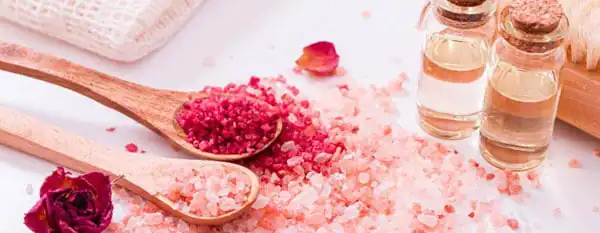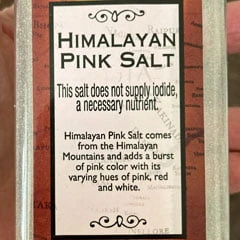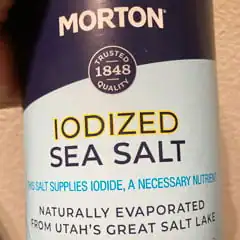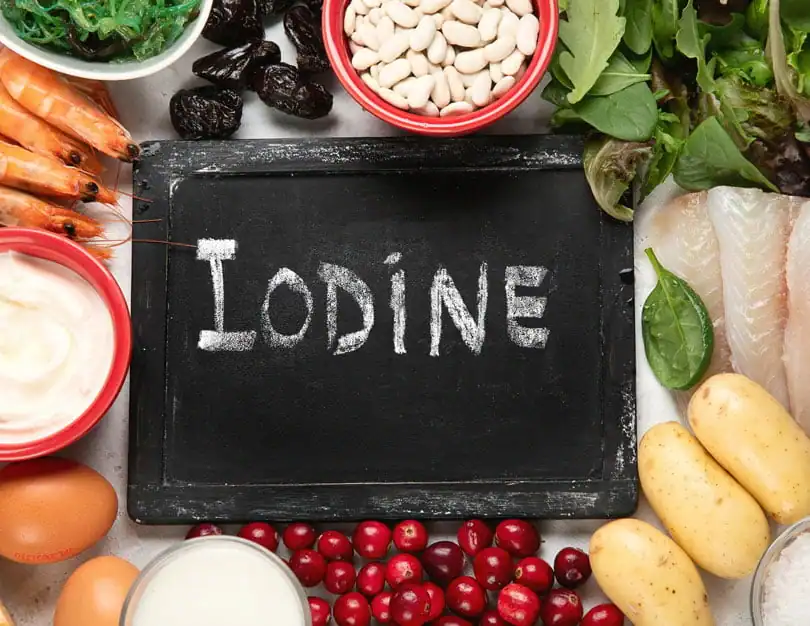Himalayan salt, also known as pink salt, is a type of rock salt that contains all sorts of natural minerals including iodine…but just how much iodine is in there?
In this article, I wanted to explore the details of iodine in Himalayan salt and provide you with the information you need to make informed decisions about your salt consumption or just to satisfy your curiosity.
What’s the difference: iodide vs. iodine
Here is the definition from Dictionary.com:
The term iodide can refer to any chemical compound that includes the element iodine. The word iodide can also be used in a more specific way to refer to a salt of hydriodic acid (hydrogen plus iodine) composed of two elements, one of which is iodine. Sodium Iodide is one example of such a salt.
Okay – maybe the real question is ‘Does Pink Himalayan Salt have IODIDE?’. From what I can see on labels, ‘Iodide’ is what gets added to the salt to fortify it. ‘Iodine’ is used on the Nutrition Facts table on the back of the container, as the element that is being supplied.
Confusing? Yes indeed! So pardon me in this article if I use the wrong word. ;)

Does Himalayan Salt Have Iodine?
Himalayan salt, also known as pink salt, is believed to be a pure and natural form of salt that contains many trace minerals, including iodide. However, the amount of iodine present in Himalayan salt can vary depending on the specific source and quality of the salt. It is rare to find Pink Himalayan salt that has been fortified with Iodide.
If you are concerned about your iodine intake, it is recommended to get it from other sources, such as Iodized salt, seafood, dairy products, or supplements.
Is Himalayan Salt A Good Source Of Iodine?
In general, the amount of iodine in Himalayan salt is fairly low and is not considered a reliable source for dietary purposes. Iodine is an essential nutrient that is required for the proper function of the thyroid gland, which produces hormones that regulate metabolism and other important bodily functions.
The World Health Organization recommends that people consume at least 150 micrograms of iodide per day to prevent iodine deficiency and related health problems. However, the amount of iodine present in Himalayan salt is usually too low to meet this requirement.
While some sources of Himalayan salt may contain small amounts of iodine, the amount can vary greatly depending on the specific source and quality of the salt. It is not uncommon for Himalayan salt to contain less than 10% of the daily recommended intake of iodine per serving. Therefore, it is not recommended to rely on Himalayan salt as a primary source of iodine in your diet.
How Much Iodine Is In Himalayan Salt?
It is difficult to determine the exact amount of iodine in Himalayan salt because the mineral content can vary significantly from one source to another. Some sources of Himalayan salt may contain higher levels of iodine than others.

Check the label of your pink salt to see if the supplier has given you the information. Most Himalayan Salt labels simply say something like “This salt does not supply Iodide, a necessary nutrient”.
You definitely don’t want to rely on Himalayan salt solely for your daily iodine intake since it is so low and fluctuates between different types/brands, so supplementing it with one of the methods mentioned above is important.
Is Himalayan Salt Better For You Than Regular Table Salt Because It Contains Iodine?
Regular table salt is typically iodized, meaning that it has been fortified with iodide to prevent iodine deficiency. While Himalayan salt may contain trace amounts of iodine, it is not a reliable source for dietary purposes.
It is not uncommon for Himalayan salt to contain less than 10% of the daily recommended intake of iodine per serving. Therefore, it is not recommended to rely on Himalayan salt as a primary source of iodine in your diet.
In terms of overall health, it is important to maintain a balanced diet that includes a variety of nutrients. While Himalayan salt may contain various trace minerals, it is not necessarily better for you than regular table salt.
Do All Types Of Himalayan Salt Contain The Same Amount Of Iodide?
It’s common for different sources of Himalayan salt to contain varying amounts of iodide. Minerals in Himalayan salt can depend on mining locations, salt quality, and processing methods used. As a result, it’s not accurate to assume that all types of Himalayan salt contain the same amount of iodine.
It is difficult to determine the exact amount of iodine in Himalayan salt because the mineral content can vary significantly from one source to another. Some sources of Himalayan salt may contain higher levels than others. However, no matter the location or quality, Himalayan salt is rarely a sufficient source for the daily requirement of iodine.
What Are Good Sources For Iodine?
One common source of iodine is iodized salt which is regular table salt that has been fortified with iodide to prevent iodine deficiency. It is widely available and can be found at most supermarkets. One quarter teaspoon of iodized salt contains about 40% of the daily recommended intake of iodide.

For other foods that provide a good source of Iodine from your diet, see The Importance of Iodized Salt for a list of foods and the amount of Iodine per serving. That article also answers a lot of questions that people have about iodized salt in general.
You can get Iodized Sea Salt (above) or Iodized Table Salt from Morton (below), for example. If you read the label though, you can see that while this salt is naturally evaporated, the source is the Great Salt Lake which technically used to be ocean/seawater, but not recently.
If you are looking for an iodine fortified salt, Morton's is a reliable choice. This table salt comes in the familiar blue round cardboard container.
Other good sources of iodine include seafood, dairy products, and eggs. Seafood, such as cod, shrimp, and tuna, is a rich source. Dairy products, such as milk and yogurt, also contain iodine. Eggs also contain small amounts of iodine.
What I do is to use common table salt that has been iodized in baking, in food preparation (such as salting the pasta water) and other uses where the salt is mixed with the food. I use interesting and flavorful Sea Salts, including Pink Himalayan salt on top of my food when it is served. That way I am always assured of getting my iodine, but I get the full effect of the gourmet salts for my food enjoyment.
In addition to dietary sources, iodine can also be obtained through supplements. Supplements are available in various forms, including tablets, capsules, and liquid drops. It is important to speak with a healthcare professional before taking any supplements to determine the appropriate dosage and ensure that they are safe and appropriate for you.
Pink Himalayan Salt That Has Been Iodized
There are a few products on the market that contain pink Himalayan salt, and then the company packaging the salt has fortified the product with Iodine. Usually, this means adding Potassium Iodate. I had to search for a while to find a domestic supplier of Iodized Himalayan salt with good package labeling, so I’m going to share that link with you to save time.
This salt starts as natural pink Himalayan salt from Pakistan, and then the folks that package it fortify the salt with Iodine. This link takes you to the coarse grain variety, but the supplier also has a fine ground type available. A 1/4 teaspoon serving of this salt provides 30 mcg of Iodine (20% of the daily requirement).
What Are The Iodine Levels Of Various Types Of Salt?
Other than iodized salt…which has specifically been fortified with iodide…other salts tend to contain low amounts of iodide. Here is a list of some common types of salt and their approximate iodide content per serving:
- Iodized Table Salt – Contains about 40% (60 micrograms) of the daily recommended intake of iodine per 1/4 teaspoon serving
- Sea Salt, Himalayan Salt, Kosher, Celtic Salt, Rock Salt – Can vary greatly in iodine content, but generally contains less than 10% of the daily recommended intake per serving (less than 15 micrograms).
It’s important to note that the iodine content of salt can vary depending on the specific source and quality of the salt. The amounts listed above are approximate and should be used as a general guide only. If you are concerned about your iodine intake, it is a good idea to speak with a healthcare professional for personalized advice.
Table of Contents
Wondering about other elements in Pink Himalayan Salt? Check out our article on Minerals In Himalayan Salt: Let’s See What’s In There.









